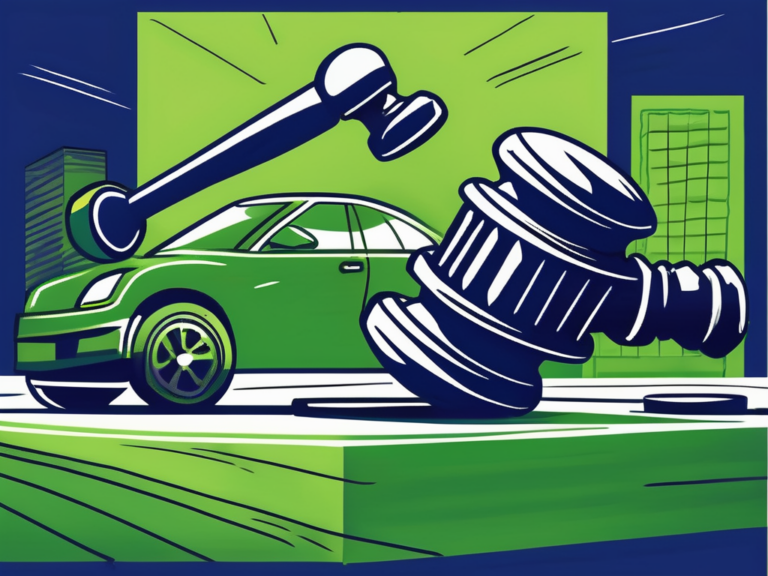Talk to Sales: (401) 200-6026

In today’s competitive auto industry, organizations must implement proactive strategies to maximize their sales and stay ahead of the curve. By understanding the importance of proactive strategies and implementing them effectively, auto dealerships can achieve significant success. This article will explore the key components of proactive strategies, steps to develop and implement them, measuring their impact on auto sales, and future trends in this area.
Understanding Proactive Strategies in Auto Sales
When it comes to the auto sales industry, staying ahead of the game is crucial for success. In a rapidly changing market, dealerships must be proactive in their approach to anticipate and address potential challenges and opportunities. By taking deliberate actions and staying ahead of industry trends and customer demands, dealerships can maximize their sales and maintain a competitive edge.
The Importance of Proactive Strategies
Proactive strategies are essential for dealerships to thrive in today’s dynamic auto market. By being proactive, dealerships can anticipate changes in customer preferences, market trends, and industry regulations. This allows them to adapt their strategies accordingly and stay ahead of the competition.
Moreover, proactive strategies enable dealerships to identify and seize new opportunities. By constantly monitoring the market and customer behavior, dealerships can identify emerging trends and adjust their offerings to meet customer demands. This not only helps in increasing sales but also enhances customer satisfaction and loyalty.
Key Components of Proactive Strategies
Implementing proactive strategies requires a comprehensive approach involving various key components. First and foremost, dealerships need to have a clear understanding of their target market and customer preferences. By conducting thorough market research and analyzing customer data, dealerships can gain valuable insights into customer behavior, preferences, and buying patterns.
Moreover, proactive strategies involve effective communication and engagement with customers. Building long-lasting relationships and providing exceptional customer service is crucial. Regularly reaching out to existing customers, following up on inquiries, and offering personalized recommendations can help build trust and loyalty. This not only leads to repeat business but also positive word-of-mouth referrals.
Additionally, staying up-to-date with technological advancements and industry best practices is vital. Dealerships should invest in innovative tools and software that can streamline their operations, improve inventory management, and enhance the customer experience. By leveraging technology, dealerships can gain a competitive advantage and deliver exceptional service to their customers.
Furthermore, proactive strategies involve continuous learning and improvement. Dealerships should encourage their staff to stay updated with industry trends and attend training programs to enhance their skills. This ensures that the dealership is always equipped with the latest knowledge and expertise to meet customer needs effectively.
In conclusion, proactive strategies are crucial for the success of auto dealerships. By anticipating and addressing potential challenges and opportunities, dealerships can stay ahead of the competition and maximize their sales. By understanding their target market, engaging with customers, leveraging technology, and fostering continuous improvement, dealerships can create a strong foundation for long-term success in the auto sales industry.
Sell cars on the lot faster with AutoRaptor
Know if we’re the right fit within 10 minutes
Implementing Proactive Strategies for Auto Sales
Implementing proactive strategies in auto sales is essential for staying ahead in a competitive market. By taking a proactive approach, dealerships can anticipate customer needs, address challenges, and seize opportunities. Developing and executing a proactive strategy requires careful planning and execution. Here are the key steps to follow:
- Identify Goals: Start by setting specific and measurable goals for your dealership’s sales performance and market share. These goals will serve as a guiding force throughout the strategy development process.
- Assess Market Trends: Conduct thorough market research to identify emerging trends, customer preferences, and competitor strategies. Understanding the market landscape will help you make informed decisions and stay ahead of the curve.
- Analyze Customer Data: Gather and analyze customer data to gain insights into their buying behavior, preferences, and pain points. This data will help you tailor your proactive strategies to meet the needs of your target audience.
- Create Action Plans: Based on the market analysis and customer insights, develop action plans to address challenges and leverage opportunities. These action plans should be specific, measurable, achievable, relevant, and time-bound (SMART).
- Collaborate with Team: Involve key stakeholders, such as sales managers and staff, in the strategy development process to ensure buy-in and alignment. Collaboration fosters a sense of ownership and increases the chances of successful implementation.
- Allocate Resources: Allocate resources, such as budget and manpower, to implement the action plans effectively. Adequate resources are crucial for executing proactive strategies and achieving desired outcomes.
- Monitor and Adapt: Continuously monitor the results of your proactive strategies and refine them as needed. Stay agile and adaptable in response to market changes. Regularly review key performance indicators (KPIs) to track progress and make data-driven adjustments.
Implementing proactive strategies may come with its own set of challenges. One common challenge is resistance to change within the organization. To overcome this, dealership leaders must communicate the benefits of proactive strategies and involve employees in the decision-making process. Training programs and incentives can also motivate staff to embrace the changes.
Another challenge is effectively managing and leveraging data to drive the strategy. Dealerships need robust customer relationship management (CRM) systems to collect, analyze, and utilize customer data effectively. Regular training and support should be provided to ensure staff members can harness the power of data in their day-to-day operations. By overcoming these challenges, dealerships can maximize the potential of their proactive strategies and achieve sustainable growth in the auto sales industry.
Approaches to Proactive Strategies
1. Embrace Digital Transformation:
The modern car buyer’s journey starts online. Dealerships must establish a strong online presence through a user-friendly website, active social media profiles, and effective search engine optimization (SEO). This allows potential customers to research, compare, and even initiate contact before visiting the physical showroom. Furthermore, embracing digital tools like virtual showrooms, 360-degree car views, and online chat support can enhance the online experience, leading to higher engagement and increased sales.
2. Personalized Customer Engagement:
Building meaningful relationships with customers goes beyond the transaction. Dealerships should invest in customer relationship management (CRM) systems to track customer interactions and preferences. This data can be used to send personalized communications, such as targeted promotions, special offers, and reminders for vehicle servicing. Such proactive engagement not only keeps customers engaged but also encourages repeat business and referrals.
3. Emphasize Education:
Auto buyers appreciate dealerships that prioritize educating them about their options. Hosting workshops, webinars, or informational videos about various car models, features, and technology can empower customers to make informed decisions. Providing easy-to-understand guides on financing options, leasing, and maintenance can build trust and confidence, ultimately leading to more conversions.
4. Implement Predictive Analytics:
Leverage the power of data by implementing predictive analytics to anticipate customer needs and preferences. By analyzing past purchase behaviors and market trends, dealerships can tailor their inventory and marketing efforts to match what customers are likely to want. This proactive approach minimizes the risk of overstocking or understocking specific models, leading to optimized sales and inventory management.
5. Offer Exceptional Customer Service:
A reputation for outstanding customer service can set a dealership apart from its competitors. Train staff to be knowledgeable, courteous, and attentive to customer inquiries. Implement a feedback loop that encourages customers to provide input after their purchase. Addressing concerns promptly and effectively demonstrates a commitment to customer satisfaction, which can result in repeat business and positive word-of-mouth referrals.
6. Create Limited-Time Offers:
Proactive strategies can include creating a sense of urgency through limited-time offers and promotions. Flash sales, seasonal discounts, and exclusive bundles can incentivize potential buyers to take action sooner rather than later. These strategies capitalize on the psychological principle of FOMO (fear of missing out) and can result in increased sales during targeted periods.
7. Foster Community Engagement:
Engaging with the local community can build goodwill and increase brand visibility. Dealerships can sponsor local events, partner with charities, or organize community drives. Such initiatives not only contribute positively but also enhance the dealership’s reputation, making it the go-to choice for customers who want to support businesses with a strong social conscience.
Sell cars on the lot faster with AutoRaptor
Know if we’re the right fit within 10 minutes
Measuring the Impact of Proactive Strategies on Auto Sales
When it comes to measuring the effectiveness of proactive strategies in the automotive industry, dealerships rely on key performance indicators (KPIs) to gauge their success. These KPIs serve as valuable metrics that provide insights into various aspects of auto sales performance.
Key Performance Indicators for Auto Sales
Dealerships track a range of KPIs to evaluate the impact of their proactive strategies. One of the most important KPIs is sales revenue, which directly reflects the financial success of the dealership. By monitoring sales revenue, dealerships can assess the effectiveness of their proactive strategies in driving sales and generating revenue.
Another crucial KPI is market share. This metric allows dealerships to understand their position in the market compared to their competitors. By analyzing market share data, dealerships can determine whether their proactive strategies are helping them gain a larger share of the market or if they need to adjust their approach to stay competitive.
Customer retention rate is yet another important KPI for dealerships. This metric measures the percentage of customers who continue to purchase vehicles from the same dealership. A high customer retention rate indicates that proactive strategies, such as excellent customer service and personalized marketing efforts, are effectively building customer loyalty and satisfaction.
Lastly, average transaction value is a KPI that provides insights into the profitability of each sale. By tracking this metric, dealerships can determine whether their proactive strategies are attracting customers who are willing to spend more on their vehicles, thus increasing the overall profitability of the dealership.
By regularly monitoring these KPIs, dealerships can gain a comprehensive understanding of the impact of their proactive strategies on auto sales. Armed with this data, they can make informed and data-driven decisions to optimize their strategies and drive further success.
Interpreting Sales Data for Strategy Refinement
Data analysis plays a crucial role in the refinement of proactive strategies in the automotive industry. Dealerships rely on sales data to identify trends, potential bottlenecks, and areas for improvement.
For example, if a specific vehicle model shows a declining sales trend, dealerships can use sales data to investigate the underlying reasons. It could be that the model is no longer appealing to customers, or perhaps the marketing efforts for that particular model need to be revised. By analyzing the sales data, dealerships can gain valuable insights into the factors influencing the decline and take appropriate actions to address the issue.
Moreover, sales data can help dealerships identify potential bottlenecks in their sales process. For instance, if there is a significant drop-off in sales at a particular stage of the customer journey, dealerships can investigate the reasons behind it. It could be due to a lack of information provided to customers, a lengthy and complicated purchasing process, or other factors. By pinpointing these bottlenecks through data analysis, dealerships can streamline their sales process and improve the overall customer experience.
Furthermore, sales data can reveal areas for improvement in proactive strategies. By analyzing the performance of different marketing campaigns, dealerships can identify which strategies are yielding the best results. They can then allocate their resources more effectively, focusing on the strategies that have proven to be most successful in driving sales.
In conclusion, leveraging sales data is essential for dealerships to continuously refine their proactive strategies and improve their overall sales performance. By analyzing key performance indicators and interpreting sales data, dealerships can make data-driven decisions that optimize their strategies and drive success in the competitive auto sales industry.
Future Trends in Proactive Auto Sales Strategies
Technological Advancements and Proactive Strategies
Technology will continue to play a significant role in the future of proactive auto sales strategies. Artificial intelligence (AI) and machine learning can help dealerships analyze vast amounts of data and provide personalized recommendations to customers. Virtual reality (VR) and augmented reality (AR) technologies can enable immersive online car shopping experiences, allowing customers to visualize and customize their dream cars from the comfort of their homes. Embracing these technological advancements will be crucial for dealerships looking to maximize their sales in the future.
Adapting to Changing Consumer Behavior
Consumer behavior is constantly evolving, and dealerships need to adapt their proactive strategies accordingly. As more customers embrace online car shopping and digital channels, dealerships must invest in robust online platforms and provide seamless omnichannel experiences. Emphasizing convenience, transparency, and personalized service will be essential to meet the changing expectations of customers and drive sales.
In conclusion, proactive strategies are vital for maximizing auto sales and staying ahead of the competition. By understanding the importance of proactive strategies, implementing them effectively, measuring their impact, and staying aware of future trends, auto dealerships can achieve long-term success in the dynamic auto industry.
Want to improve your sales and move cars off the lot faster? Book a test drive with AutoRaptor to see how our simple dealership CRM software can help you close more deals effectively.
Subscribe to our Newsletter
Resources to help your dealership convert more leads into sales, retain more customers, and market inventory smarter, straight to your inbox every Sunday.




